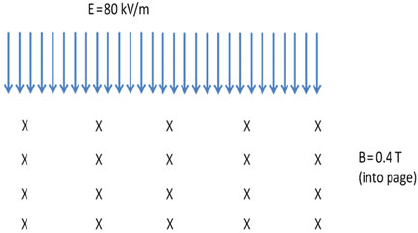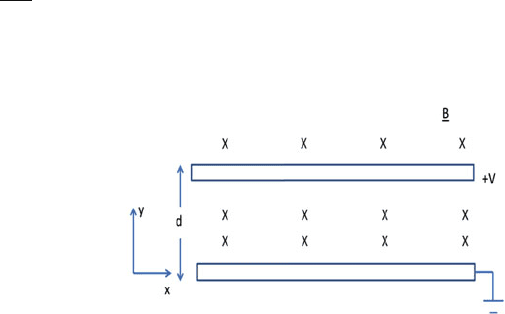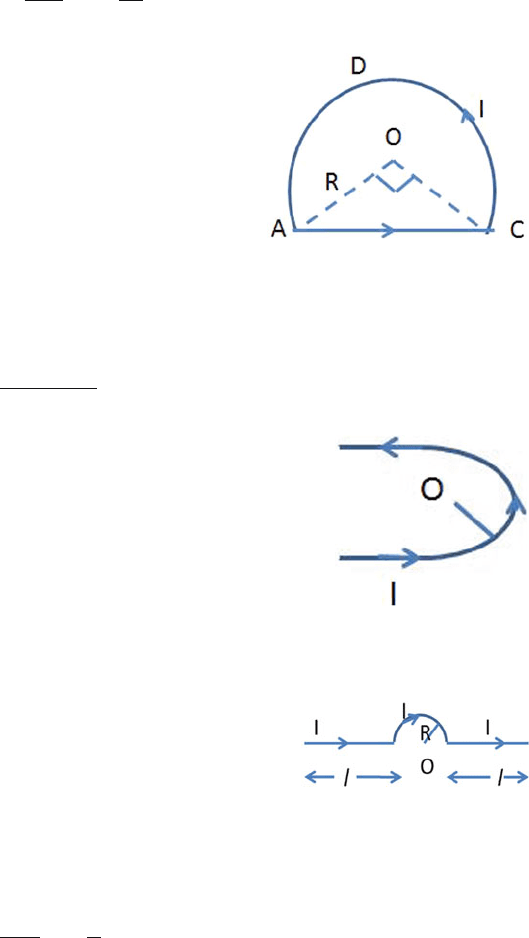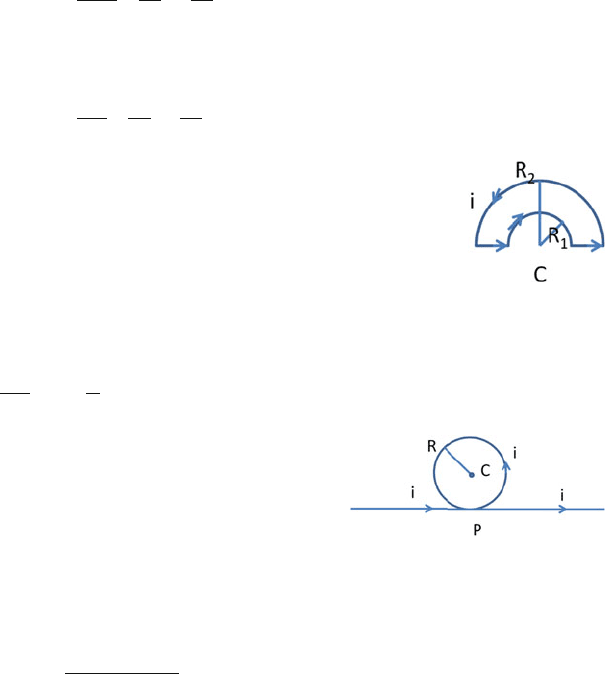Kamal A.A. 1000 Solved Problems in Classical Physics: An Exercise Book
Подождите немного. Документ загружается.


580 13 Electromagnetism I
Null deflection: If the electric and magnetic fields are crossed, i.e. arranged at
right angles then the charged particle is undeflected. The condition is
v = E/B (13.5)
Magnetic Induction (B)
B at the Centre of a Coil of N Turns and of Radius r, Carrying Current i
B =
μ
0
Ni
2r
(centre of coil) (13.6)
The field into the page is indicated by a cross X and out of page by a dot.
B at Distance r from a Long Straight Wire
B =
μ
0
i
2πr
(long wire) (13.7)
B at Distance r from a Straight Wire of Finite Length
B =
μ
0
i
4πr
(cos θ
1
+ cos θ
2
)(finite wire) (13.8)
where θ
1
and θ
2
are the inner angles subtended by the field point at the extremities
of the wire.
B on the Axis of a Solenoid
B =
μ
0
Ni
l
(solenoid) (13.9)
where N is the number of turns over the axial length l.
Magnetic Induction due to a Long Cylindrical Conductor of Radius R
B =
μ
0
ir
2π R
2
(r < R)
=
μ
0
i
2πr
(r > R) (13.10)

13.1 Basic Concepts and Formulae 581
B due to a Hollow Cylindrical Shell of Radii a and b (a < b)
B =
μ
0
i(r
2
− a
2
)
2πr(b
2
− a
2
)
(a < r < b)
= 0 (r < a)
=
μ
0
i
2πr
(r > b) (13.11)
where r is measured from the axis.
B due to a Loop of N Turns and Radius r on the Axis
B =
μ
0
iN R
2
2(R
2
+ z
2
)
3/2
(13.12)
Magnetic Force on a Current-Carrying Wire
The force on the current-carrying wire is directed perpendicular to both the length
of the wire and the field direction. The direction of motion of the wire is given by the
left-hand rule. If the current-carrying wire makes an angle θ with the field direction,
then the force on the wire would be
F = ilB sin θ (13.13)
Force on Two Parallel Wires Each of Length l Carrying Current i
1
and i
2
and Separated by Distance d
F =
μ
0
li
1
i
2
2πd
(13.14)
The two forces (F
1
due to wire 1 on 2 and F
2
due to wire 2 on 1) form an action–
reaction pair. For parallel currents the wires attract each other and for antiparallel
currents the wires repel each other.
Magnetic Dipole Moment, Magnetic Energy
Magnetic Material, Hall Effect
The magnetic moment produced by a circular current i enclosing an area A is given
by
μ = Ai (13.15)

582 13 Electromagnetism I
Magnetic energy density
u
B
=
1
2μ
0
B
2
(13.16)
Magnetic material
B = μ
0
(H + M) (13.17)
where H is the magnetic field strength and M is the magnetization.
Hall effect: When a strip of conductor carries a dc current along its length, a mag-
netic field set up in a perpendicular direction produces a magnetic field sideways.
The charge build up on one side establishes a potential across the width of the strip,
known as Hall potential and the phenomenon is called Hall effect.
If R
H
is the Hall coefficient, σ the electrical conductivity, then the mobility μ is
given by
μ = R
H
σ (13.18)
Lorentz Force
F = q E +qv × B (13.19)
Faraday’s Law
An emf is induced in a conductor when there is a change in the number of lines
‘linking it’ (passing through it) or when it cuts across field lines.
Consider a flat wire loop of any shape and of area A in a magnetic field B,the
field B making an angle θ perpendicular to the loop. The magnetic flux ϕ through
the loop is defined by
ϕ = B. A = BAcos θ (13.20)
The unit of flux is the weber (Wb), while that of the magnetic field is tesla (T).
1T= 10
4
G, G standing for Gauss.
The electromotive force ξ in such a wire loop is equal to the rate of change of
flux through it:
ξ =−
ϕ
t
(Faraday’s law) (13.21)
where ϕ is the change in flux that occurs in time interval t.

13.2 Problems 583
Lenz law: The reason for the minus sign in (13.21) is given by Lenz law which
states ‘the induced current will appear in such a direction that it opposes the change
that produced it’.
If the coil forms a closed circuit then only the induced current can be present,
otherwise in the case of an open circuit one can only speak of induced emf and its
direction.
In a coil of N turns
ξ =−N
ϕ
t
(13.22)
If the circuit is complete current will appear and will be given by
i =
ξ
R
=−
N
R
ϕ
t
(13.23)
where R is the resistance of the circuit. The corresponding charge flowing is given
by
q = it =−
N
R
ϕ (13.24)
Consider a conducting rod of length l moving sideways in the plane of paper over
a U-shaped metal frame at constant speed v at right angles to a uniform magnetic
field of flux density B into the paper. Then the emf induced across the ends of the
rod is given by
ξ =−Blv (13.25)
13.2 Problems
13.2.1 Motion of Charged Particles in Electric and Magnetic Fields
13.1 Calculate the cyclotron frequency to accelerate alpha particles in a magnetic
field of 10
4
G. The mass of
4
He
2
is 4.002603 u.
13.2 If the pole pieces of a cyclotron are 50 cm in diameter, a flux density of
15,000 G, find approximate values for the energies to which (a) protons
and (b) α-particles could be accelerated. What oscillator frequency would
be required in each case?
[University of London]
13.3 In a mass spectrometer, the velocity filter employs electric field E and a
perpendicular magnetic field B. The deflection magnetic field, perpendicular
to a beam is B
. I ons with similar charges q and mass numbers m
1
and

584 13 Electromagnetism I
m
2
pass through the filter. Show that the separation between them will be
2E(m
2
− m
1
)
qB B
[Indian Administrative Services]
13.4 A singly charged particle of known velocity 2.5 × 10
7
m/s but unknown
mass moves in a bubble chamber in a circular path of radius 0.2 m in a field
of 0.2 T acting perpendicular to the path. Determine the mass of the particle
and identify it.
13.5 A particle of mass m and charge q travelling with a velocity v along the
x-axis enters a uniform electric field E directed along the y-axis. Show that
the trajectory will be a parabola.
13.6 Find the radius of a circular orbit of an electron of energy 5 keV in a field of
10
−2
T.
[Osmania University 1992]
13.7 An electric field of 1500 V/m and a magnetic field act on an electron moving
with a speed of 3000 m/s. If the resultant field is to be zero what should be
the strength of the magnetic field (in Wb/m
2
).
[Osmania University 1987]
13.8 An electron moves in a circle of radius 1.9 m in a magnetic field of 3 ×
10
−5
T. Calculate (a) the speed of electrons and (b) time taken to move round
the circle.
13.9 A cyclotron is powered by a 50,000 V 5 Mc/s radio frequency source. If its
diameter is 1.524 m, what magnetic field satisfies the resonance condition for
deuterons?. Also what energies will they attain? Take the mass of deuteron
as 2.0141 u.
13.10 Deuterons are accelerated in a conventional cyclotron. Given the resonance
frequency was 11.5 Mc/s and radius of the dee 30
, calculate the resonance
frequency of protons and the maximum energy of protons that is obtainable
using the same magnetic field. (In a cyclotron the vacuum chamber is parti-
tioned into two D-shaped components)
13.11 A cyclotron has a magnetic field of 15,000 G. The extraction radius is 50 cm.
Calculate (a) the frequency of the rf necessary for accelerating deuterons and
(b) the energy of the extracted beam.
[University of Liverpool]
13.12 In the Bohr model of hydrogen atom the electron revolves in a circular orbit
of radius 0.53 Å with a time period of 1.5 ×10
−16
s. Find the corresponding
current.

13.2 Problems 585
13.13 AsshowninFig.13.1, a beam of particles of charge q enters a region where
an electric field is uniform and directed downwards. Its value is 80 kV/m.
Perpendicular to E and directed into the page is a magnetic field B = 0.4T.
(i) If the speed of the particles is properly chosen, the particles will not be
deflected by these crossed electric and magnetic fields. What speed is
selected in this case?
(ii) If the electric field is cut off and the same magnetic field is maintained,
the charged particles move in the magnetic field in a circular path of
radius 1.14 cm. Determine the ratio of the electric charge to the mass of
the particles.
Fig. 13.1
13.14
(a) Write an expression for the force acting on a charge q moving with
velocity v in an electric field E and magnetic field B.
(b) A charged particle of mass m and charge q is accelerated through a
potential difference of V and then injected into a region with a magnetic
field B perpendicular to the plane in which the charge moves. Derive an
expression for the radius of curvature, r, of the path of the particle when
in the magnetic field.
[University of Durham 2004]
13.15 In a certain mass spectrometer the magnetic field has a magnitude of 0.2 T.
It is intended that this spectrometer be used to separate two isotopes of ura-
nium,
235
92
U(mass 3.90×10
−25
kg) and
238
92
U(mass 3.95×10
−25
kg). In order
to be separated the radii of curvature described by singly charged (charge +e)
ions must differ by 2 mm. Calculate the electric potential through which the
ions must be accelerated in order to achieve this.
13.16
(a) Write down an expression for the force experienced by a particle with
charge q moving with velocity v in a magnetic field B. Under what
circumstances does the particle mass m, of describe a circle of radius r?
(b) A coil of cross-sectional area A composed of N turns is placed perpen-
dicular to a magnetic field which is uniform in space, with a strength that

586 13 Electromagnetism I
varies in time according to B = B
0
cos(15t). Calculate the electromotive
force induced in the coil.
[University of Manchester 2007]
13.17 A water droplet of radius 1 μm is charged such that the electric field on its
surface is 5.8 mV/m. (a) How many electrons does the droplet carry? (b) How
strong a vertical electric field is required to prevent it from falling?
13.18 An electron of energy 1 eV enters an infinitely large region containing only a
homogeneous magnetic field of 10
−3
T, at an angle of 60
◦
to the direction of
the field. Calculate its subsequent motion assuming no energy losses. What
type of energy losses will occur even in complete vacuum?
[University of Manchester 1972]
13.19 A uniform electric field is established between the plates of a parallel plate
capacitor by holding one plate at ground and the other at a positive potential
V as shown. A uniform magnetic field B is established perpendicular to the
electric field (Fig. 13.2).
A charge −q is released from rest from the lower plate.
(i) Write down the equations of motion for the velocity components of the
charge.
(ii) Show that, at some time t later, the velocity of the electron in the x-
direction is related to the distance y moved along the y-axis by
v
x
= ωy
(iii) By applying the conservation of energy or otherwise to determine the
square of the velocity in the x–y-plane, show that
v
2
y
=
2qv
md
y − ω
2
y
2
[University of Aberystwyth, Wales]
Fig. 13.2

13.2 Problems 587
13.20 Electrons are liberated with zero velocity from the negative plate of a parallel
plate condenser, in which there is a constant magnetic field B parallel to the
plates. If the separation of the plates is d and the potential across them is V ,
show that the electrons only arrive at the positive plate if d
2
<
2mV
eB
2
[University of Durham 1962]
13.2.2 Magnetic Induction
13.21 The magnetic field at 40 cm from a long straight wire is 10
−6
T. What current
is carried by the wire?
13.22 A current I flows through a straight wire AB of finite length.
(a) Find the magnetic field B at distance r from the wire, the ends of the
wire making inner angles θ
1
and θ
2
with P,Fig.13.3.
(b) Obtain the limit value for B for a very long wire.
Fig. 13.3
13.23 The magnetic field at the centre of a circular current loop is 10
−5
T. If the
radius of the loop is 50 cm, find the current.
13.24 A square conducting loop, of side a carries a current I. Calculate the mag-
netic field at the centre of the loop.
13.25 Two wires are bent into semicircles of radius a,asinFig.13.4. The upper
half has resistance R and the lower half resistance 4R . Find the magnetic
induction at the centre of the circle.
Fig. 13.4

588 13 Electromagnetism I
13.26 A current I is sent through a thin wire as in Fig. 13.5. The radius of the
curved part of the wire is R. Show that the magnetic induction at the point O
will be B =
μ
0
i
2π R
1 +
3π
4
Fig. 13.5
13.27
(a) A current I is sent through a thin wire as in Fig. 13.6. The straight wires
are very long and the radius of the curved part of the wire is R. Show
that the magnetic induction at the point O will be
B =
μ
0
I (π + 2)
4π R
Fig. 13.6
(b) A wire shown in Fig. 13.7 carries current I . Find the field of induction
B at the centre O.
Fig. 13.7
13.28
(a) A wire in the form of a polygon of n sides is circumscribed by a circle
of radius a. If the current through the wire is i, show that the magnetic
induction at the centre of the circle is given by
B =
μ
0
ni
2πa
tan
π
n
(b) Show that in the limit n →∞you get the expected result.

13.2 Problems 589
13.29 A wire of length l can form a circle or a square. A current i issetupinboth
the structures. Show t hat the ratio of magnetic induction at the centres of
these structures will be approximately 0.87.
13.30 (a) C is the common centre of the circular arcs of the circuit-carrying current
i, its arcs cutting a sector of angle, θ. Show that the magnetic induction
at C is
B =
μ
0
iθ
4π
1
R
1
−
1
R
2
(b) C is the common centre of the semicircular arc of radii R
1
and R
2
,
Fig. 13.8, carrying current i. Show that the magnetic induction at C is
B =
μ
0
i
4
1
R
1
−
1
R
2
Fig. 13.8
13.31 A long wire is bent into the shape as in Fig. 13.9, without any cross-contact
at P. The current flows as indicated with the circular portion having radius
R. Show that the magnetic induction at C, the centre of the circle is B =
μ
0
i
2R
1 +
1
π
Fig. 13.9
13.32 A current I flows through a ring of radius r placed in the xy-plane. Show that
the magnetic induction at a point along the z-axis passing through the centre
of the ring is given by
B(z) =
μ
0
IR
2
2(R
2
+ z
2
)
3/2
13.33 Five hundred turns of a wire are wound on a thin tube 1 m long. If the wire
carries a current of 5 A, determine the field in the tube.
13.34 Two parallel wires, a distance d apart, carry equal currents I in opposite
directions. Calculate the magnetic induction B for points between the wires
at a distance x from one wire.
[Adapted from Hyderabad Central University 1993]
